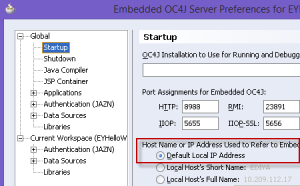You have insufficient privileges for the current operation. Please contact your System Administrator.
You cannot run a page which is not Self Secured when the MAC fails.

In JDeveloper, go to menu Tools–>Embedded OC4J Server Preferences–>Global–>Startup–>Select Default Local IP Address.

$INST_TOP/appl/$CONTEXT_NAME/admin/log/$MMDDHHMM/adconfig.log
Db:
$ORACLE_HOME/appsutil/log/$CONTEXT_NAME/adconfig.log $ORACLE_HOME/appsutil/log/$CONTEXT_NAME/NetServiceHandler.log
Startup/Shutdown Log files:
Apache, OC4J and OPMN:
$LOG_HOME/ora/10.1.3/j2ee
$LOG_HOME/ora/10.1.3/opmn
Patch log:
Workflow Mailer log:
Concurrent log:
Clone log:
Apps:
$INST_TOP/apps/$CONTEXT_NAME/admin/log/ (StageAppsTier_MMDDHHMM.log)
Db:
$ORACLE_HOME/appsutil/log/$CONTEXT_NAME/(StageDBTier_MMDDHHMM.log)
Clone log files in target instance:
$INST_TOP/apps/$CONTEXT_NAME/admin/log/ApplyAppsTier_.log
Db:
$ORACLE_HOME/appsutil/log/$CONTEXT_NAME/ApplyDBTier_.log
– Alert Log File:
$ORACLE_HOME/admin/$CONTEXT_NAME/bdump/alert_$SID.log
- $APPLCSF – the top level directory where the concurrent manager stores the log and out files of concurrent requests
- $APPLCSF/$APPLLOG – concurrent request log files( As describe above)
- $APPLCSF/$APPLOUT – concurrent request out files( As describe above)
- $APPLTMP – Applications temporary files
- $APPLPTMP – PL/SQL temporary files or /usr/tmp (default tmp directory)
$INST_TOP/logs/ora/10.1.3/Apache/error_log[timestamp]
$INST_TOP/logs/ora/10.1.3/opmn/ (OC4J~…, oa*, opmn.log)$INST_TOP/apps/$CONTEXT_NAME/logs/ora/10.1.2/network/ (listener log)
$INST_TOP/logs/appl/conc/log (CM log files)
1) Database Tier
1.1) Relink Log files :
$ORACLE_HOME/appsutil/log/$CONTEXT_NAME /MMDDHHMM/ make_$MMDDHHMM.log
1.2) Alert Log Files :
$ORACLE_HOME/admin/$CONTEXT_NAME/bdump/alert_$SID.log
1.3) Network Logs :
$ORACLE_HOME/network/admin/$SID.log
1.4) OUI Logs :
OUI Inventory Logs :
$ORACLE_HOME/admin/oui/$CONTEXT_NAME/oraInventory/logs
2) Application Tier
$ORACLE_HOME/j2ee/DevSuite/log
$ORACLE_HOME/opmn/logs
$ORACLE_HOME/network/logs
Tech Stack Patch 10.1.3 (Web/HTTP Server)
$IAS_ORACLE_HOME/j2ee/forms/log
$IAS_ORACLE_HOME/j2ee/oafm/log
$IAS_ORACLE_HOME/j2ee/oacore/log
$IAS_ORACLE_HOME/opmn/logs
$IAS_ORACLE_HOME/network/log
$INST_TOP/logs/ora/10.1.2
$INST_TOP/logs/ora/10.1.3
$INST_TOP/logs/appl/conc/log
$INST_TOP/logs/appl/admin/log
Developer (Developer/Forms & Reports 10.1.2) Patch – $ORACLE_HOME/.patch_storage
Web Server (Apache) patch – $IAS_ORACLE_HOME/.patch_storage
Database Tier opatch log – $ORACLE_HOME/.patch_storage
Concurrent request history should not exceed 50K rows, or else it will start impacting on performance
SQL> select count(*) from FND_CONCURRENT_PROCESSES;
COUNT(*)
———-
552
SQL> select count(*) from FND_CONCURRENT_REQUESTS;
COUNT(*)
———-
85009 ==>>> Should always be below 50K, Else run “Purge Concurrent Request”
SQL>
SQL> select count(*) from FND_CONCURRENT_REQUESTS
2 where request_date > sysdate-7;
———-
SQL> col “Min request|Date” for a20;
SQL> col “Max request|Date” for a20;
SQL> select min(request_date) “Min request|Date”,max(request_date) “Max request|Date” from FND_CONCURRENT_REQUESTS;
Min request|Date Max request|Date
——————– ——————–
18-NOV-09 01-NOV-11
SQL>
To clean old history of “COMPLETED” requests, follow the below note, to purge the queue
Concurrent Processing Tables and Purge Concurrent Request and/or Manager Data Program (FNDCPPUR) [ID 104282.1]
System Administrator -> Requests -> Run

Select “Single Request”


Mode = 14 days – delete all older than 14 days. Don’t make this window to small.

To view the above submitted request, do the following
Enter the request ID and “Find”


While Running:

Status on successful completion is shown below “Completed”, “Normal”

Extract from the Log File:
FNDCPPUR module: Purge Concurrent Request and/or Manager Data
+—————————————————————————+
Current system time is 01-NOV-2011 12:57:03
+—————————————————————————+
Purged 46616 entrie(s) from FND_CONCURRENT_REQUESTS :-01-NOV-2011 13:07:22
Purged 0 entrie(s) from FND_FILE_TEMP :-01-NOV-2011 13:07:22
Purged 7082 entrie(s) from FND_CRM_HISTORY :-01-NOV-2011 13:07:25
Purged 0 entrie(s) from FND_TM_EVENTS :-01-NOV-2011 13:07:25
Purged 346 entrie(s) from FND_TEMP_FILES :-01-NOV-2011 13:07:25
Purged 0 entrie(s) from FND_ENV_CONTEXT :-01-NOV-2011 13:07:46
Purged 1 entrie(s) from FND_DUAL :-01-NOV-2011 13:07:46
Purged 2 entrie(s) from FND_CONFLICTS_DOMAIN :-01-NOV-2011 13:07:46
+—————————————————————————+
Start of log messages from FND_FILE
+—————————————————————————+
Latest Posts
- R12 – How to Handle NULL for :$FLEX$.VALUE_SET_NAME In Oracle ERPAugust 25, 2023 - 1:20 pm
- R12 – How to Delete Oracle AR TransactionsMarch 22, 2019 - 8:37 pm
- How to Define Custom Key Flexfield (KFF) in R12January 19, 2018 - 5:43 pm
- AutoLock Box Concepts In R12November 10, 2017 - 8:30 am
- R12 – java.sql.SQLException: Invalid column type in OAFSeptember 15, 2017 - 9:39 am



Recent Comments